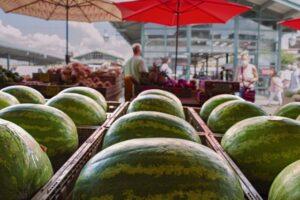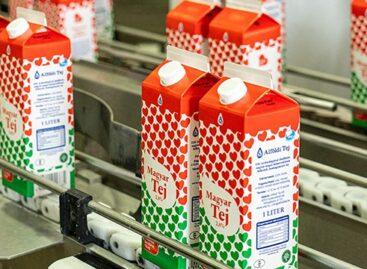Half-term melon overview: difficult season, market-destroying promotions, desperate producers
The domestic melon season started with a delay of one or two weeks due to the unusually cool and light-poor May weather, and the first plantings were largely missed. The spring weather, especially the frosts of April 7-8, completely upset the planting plans, because the seedlings planted at the end of March and beginning of April froze. Those farmers who did not take the risk of planting were forced to abandon their phased plans and plant large areas at once. The melon sowing and planting schedule was essentially disrupted across the entire Hungarian growing area, or spread out over about three weeks. However, with the heatwave weather in June, we “fell to the other side of the horse”: the ripening of the different stocks accelerated significantly, and ripening was crowded together.

(Photo: Pixabay)
Due to the extreme weather in the spring and early summer, at the beginning of the season (the last week of June and the first week of July), we harvested about a third as much fruit as in the same period last year, but from mid-July onwards, significant quantities of fruit arrived, which suddenly fell on the market in a very short period of time. The harvest results so far reflect that yields are 20-30% lower than expected, which can be primarily attributed to the cold weather in May and the drought in April-June. In many cases, we experience that this crop loss is basically caused by smaller fruit sizes, and the crop is growing according to the planned “number of pieces”. The quality of the crop is developing as expected.
The weather was not favorable for demand either
The two significant cooling waves in July significantly reduced demand. The consumption of melons is largely weather-dependent: during heatwaves characterized by temperatures above 30 degrees, consumption is 20-40% higher than on cool days. During the July cooling periods – which cover a very long period of two to three weeks in total – domestic and foreign demand fell by about 25-30%. The sudden increase in supply in July, coupled with the drop in demand, led to a sharp drop in prices from mid-July onwards: producer prices at the start of the season fell by about 60%. As a result, producers have been forced to sell at prices well below cost since mid-July, and this price level has been consistently close to the lowest prices of the same period last year for more than two weeks. This is also “painful” for producers because the yields are 20-30% lower than last year, but this has to be produced at practically the same per hectare costs as the entire harvest, so the cost per kilogram has increased in a similar proportion to the yield decrease compared to the previous year. Consumer prices have also fallen, the gross consumer prices of 250-300 HUF/kg prevailing at the beginning of the season are currently typically in the 150-200 HUF/kg range (with special prices of 149 HUF/kg).
There are no significant quantities of imported melons in Hungary, but our exports are also severely hampered
The reason for this is that consumption has decreased throughout Europe, despite the cooler than average July weather. There will certainly be no supply problems with domestic melons, the Békés melon season is coming to an end, but the Szabolcs growing region also “started” with significant quantities around July 20, so the service will be continuous.
The domestic melon season will last until the end of August
Moderately warm or cool weather is expected for the beginning of August, so we cannot expect a significant pick-up in demand in the next two weeks. Therefore, it is likely that the market disruptions due to relative oversupply will remain in the first half of the main season, which will last about a month. These disruptions can be characterized by depressed prices.
It would be very important for the current producer prices, which are below cost, to increase significantly and return to normal levels as soon as possible
It can be stated that in the case of a consumer price level below 200 HUF/kg, producer prices develop that cause substantial losses to farmers and drastically reduce producer morale. Furthermore, the price level also significantly affects quality: if the market “pays” for quality (which it does not do now), the producer can bring carefully selected goods to the market and only the best quality appears on the shelves. However, in the case of depressed prices – in order to reduce losses – it is a natural reaction that less ripe or overripe, or not necessarily representing class I quality, also appears on the market. Domestic supermarket chains have a major role and responsibility in shaping prices and thus quality, and in the long term, the desire to produce, as they predestinate the price level with their discount prices. It is a common phenomenon that hypermarkets and supermarkets follow each other in setting discount prices, thereby continuously generating a negative price spiral. It is also important for them, as key market players, to understand that fruit and vegetable production has become an activity that requires a lot of capital, labor and expertise, and is also burdened with very high production risks, so production cannot be maintained at prices around or below cost in the short term. The depressed price level is apparently good for consumers, but in the very short term it is at the expense of quality, and in the longer term it undermines the producers’ enthusiasm. Serving consumers with low prices is an important goal, but it cannot be so important that it endangers or even makes impossible the development of the melon and fruit and vegetable sectors in the long term, or even worse, the maintenance of production. In this way, we seriously endanger the provision of domestic self-sufficiency and increase exposure to imports in the long term. Preventing this harmful phenomenon even in the short term is in our common interest!
NAK
Related news
This year, 10 percent more new wine was produced than last year
🎧 Hallgasd a cikket: Lejátszás Szünet Folytatás Leállítás Nyelv: Auto…
Read more >AM: Government helps farmers with a loan moratorium
🎧 Hallgasd a cikket: Lejátszás Szünet Folytatás Leállítás Nyelv: Auto…
Read more >More than 100 Hungarian farmers also demonstrated in Brussels
🎧 Hallgasd a cikket: Lejátszás Szünet Folytatás Leállítás Nyelv: Auto…
Read more >Related news
Crowds return to stores: margin cap and year-end preparations drive retail traffic
🎧 Hallgasd a cikket: Lejátszás Szünet Folytatás Leállítás Nyelv: Auto…
Read more >The kings of the New Year’s Eve list: hot dogs and champagne in abundance
🎧 Hallgasd a cikket: Lejátszás Szünet Folytatás Leállítás Nyelv: Auto…
Read more >The Alföldi Tej case is drifting towards an uncertain outcome
🎧 Hallgasd a cikket: Lejátszás Szünet Folytatás Leállítás Nyelv: Auto…
Read more >






